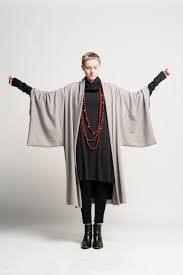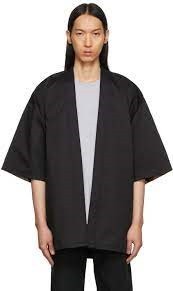How to wear a traditional Japanese haori guide, Kimono layer, kosode
How to Wear a Traditional Japanese Haori? A Complete Guide on Wearing a Japanese Haori
10 Nov 2022
The Japanese Haori is the outermost layer of the traditional Japanese Kimono. It is worn in conjunction with a kosode, or undershirt.
The Haori itself does not have any markings or designs on it, but rather consists of thin silk fabric that is both comfortable and warm. Japanese people love to wear their traditional dress, this article will provide you with a step-by-step guide to wearing a Japanese Haori so that everyone can learn how to accessorize their customary Japanese Haori properly while still being able to feel comfortable!
Japanese Kimono is a long, loose coat that is worn over the kimono. Usually made of silk or synthetic fibers, it has an open front, with a long slit in the back to allow for movement while walking. The sleeves are folded down at your wrists and fastened by cords called “kashikake” or “kashikinu” (in gold).
Types of Japanese Haori
There are four basic types of Japanese Haori:
- Kurosu-Haori (Black Haori) – This type is most commonly seen in the theater and is characterized by a black silk Hakama with an attached Obi. The Haori is most often worn with no other accessories, although you might see it wrapped around your waist or shoulders as well.
- Haku-Haori (White Haori) – The Haku-Haori is another popular form of traditional Japanese clothing that has gained popularity over time, especially among younger people who want something more modern than traditional. While there are many variations on this style, one common characteristic is its use of white silk as opposed to black for draping over the body; however, some people still prefer wearing both colors separately depending on their mood or preference at any given time!
- Nagoya Haori – This Haori type tends to be similar in appearance but differs slightly when compared with other types mentioned above due to its origin city being located near Osaka rather than Tokyo where most other cities fall under jurisdiction control during WW2 which lead many citizens living there during wartime conditions not only having difficulty getting supplies but also finding jobs due lack market demand due high demand elsewhere due war situation affecting production output significantly throughout country overall economy collapse after bombs fell heaviest hit cities including Kobe itself leaving millions dead instantly killed entire population within hours after first two explosions went off simultaneously destroying entire city infrastructure including bridges roads railways buildings etc…
- Hakama Haori – This type of Haori is the most formal and can be worn by anyone regardless of age. In some families, it is passed down from generation to generation, while in other families they are bought brand new every few years.
Who Can Wear a Japanese Haori?
Japanese Haori is the outermost layer of traditional Japanese Kimono. It is worn by both men and women, but it is mostly worn by men. A Japanese Haori can be considered an official formal attire for men in Japan because it’s considered to be one of their most important garments; hence the name “Haori” (meaning “outer robe”). It cannot be worn in activities such as sword practice where there may be movement required from your hands as well as other parts of your body while holding onto something else like a sword blade etcetera…
Traditional Japanese Haori are Made of what?
Japanese Haoris are usually made from cotton or silk and have long sleeves that end at waist level or lower depending on what type you choose to wear. The neck area is closed with buttons or zippers placed along each side seam so they don’t fall open during activities.
How to Wear a Japanese Haori?
Wearing a Japanese Haori is a straightforward process. You simply wear the Haori over your kimono, with the sleeves hanging down to your knees or below. Some people choose to wear it on their left side while others prefer to wear it on their right side so that they can accessorize with other items like belts or hakama (traditional trousers).
If you are wearing it as part of an ensemble such as “kimono + hakama + obi” then there are various ways in which you can accessorize yourself:
- You can add a collar around your neck which will help keep the collar from sagging down too far when worn over top of another article such as an obi belt;
- You may also want some sort of sleeve covering both sides so that nothing shows when viewed from above;
- A final option is to have a tailor sew in some hooks along the inside of the Haori so that it can be worn closed like a jacket. This is useful if you want to keep your Kimono clean or if it’s windy outside.
- There are many different ways that you can wear a Japanese Haori jacket, but these are just some of the most popular methods. Experiment and see what looks best on you!
- When wearing a Japanese Haori, it is important to keep the following things in mind: The Haori should be worn over top of your Kimono; The sleeves should be long enough to reach your knees or below.
- The most important thing is to make sure that you feel comfortable in it. Experiment with different styles and see what works best for you.
You may want to add a Hakama (traditional trousers) underneath your Haori to create an ensemble; or You may just want to wear the Haori as is, without any other accessories.
When to Wear a Japanese Haori?
The Japanese Haori is the outermost layer of the traditional kimono. It is worn at ceremonial occasions and formal events, as well as by men and women alike. The age range for wearing a Japanese Haori varies depending on where you live in Japan, but generally speaking, it can be worn by anyone regardless of age or gender.
Some Prominent Points of Japanese Haori
Wearing a Japanese mask or Japanese Haori is not a big deal but you must be well aware of this traditional dress so that you can carry it easily.
- A Japanese Haori is a formal garment that is worn over a kimono.
- It is made of silk and has a lining, which can be made of cotton, silk, or other materials depending on the season and the individual’s preferences.
- The lining will be white during winter but may change to any color during the summer months (for example blue).
- The Japanese Haori is made from a lightweight fabric that is usually white or black. The inside of the coat is lined with cotton, and there are two rows of buttons running across the front. It has a V-shaped collar that can be worn open or closed depending on the occasion.
It is worn over a kimono, and its purpose is to protect the wearer from cold weather. It is made of silk or cotton and can be worn in different styles depending on the season. Wearing a Japanese Haori Makes You Look Different!
Japanese Haori is the Outermost Layer of Traditional Japanese Kimono
The outermost layer of traditional Japanese Kimono is the Japanese Haori. It’s a type of kimono and it’s also considered to be one of the most formal garments worn by men in Japan.
The Japanese Haori is worn over your shikamui (sleeves), while your kimono is worn over both your hakama and hakama pants. Some Japanese people like to wear Haori Jacket without Kimono as well. This dress is not specified for festivals & occasions only but many people wear them as their daily routine dress. Many people outside Japan are also fans of this Japanese Traditional Dress( Japanese Haor).
When you wear a Japanese Haori, you are showing your respect for the traditional culture and history of Japan. It is also a great way to express yourself both on a personal level and in public settings like workplaces or school campuses. Haori is not only Traditional wear now but also modern wear.
Comments on this guide to How to wear a traditional Japanese haori article are welcome.
Home Improvement Articles
Home Improvement Posts
Warm Up Your Living Room With These Decorating Tips
Home renovation and roof replacement estimate tips
Ultimate checklist for renovating your home
Design: Yerce Architecture & ZAAS, Istanbul
photo : Yerce Art Photography – Emin Emrah Yerce
Studio Loft Izmir
House Renewal
How to Spruce Up Your Home with Personalized Prints
What is the Process of Expanding Your Home
DIY Home Improvement Projects Tools
Selecting right contractor for home care and repairs
Comments / photos for the How to wear a traditional Japanese haori advice page welcome







